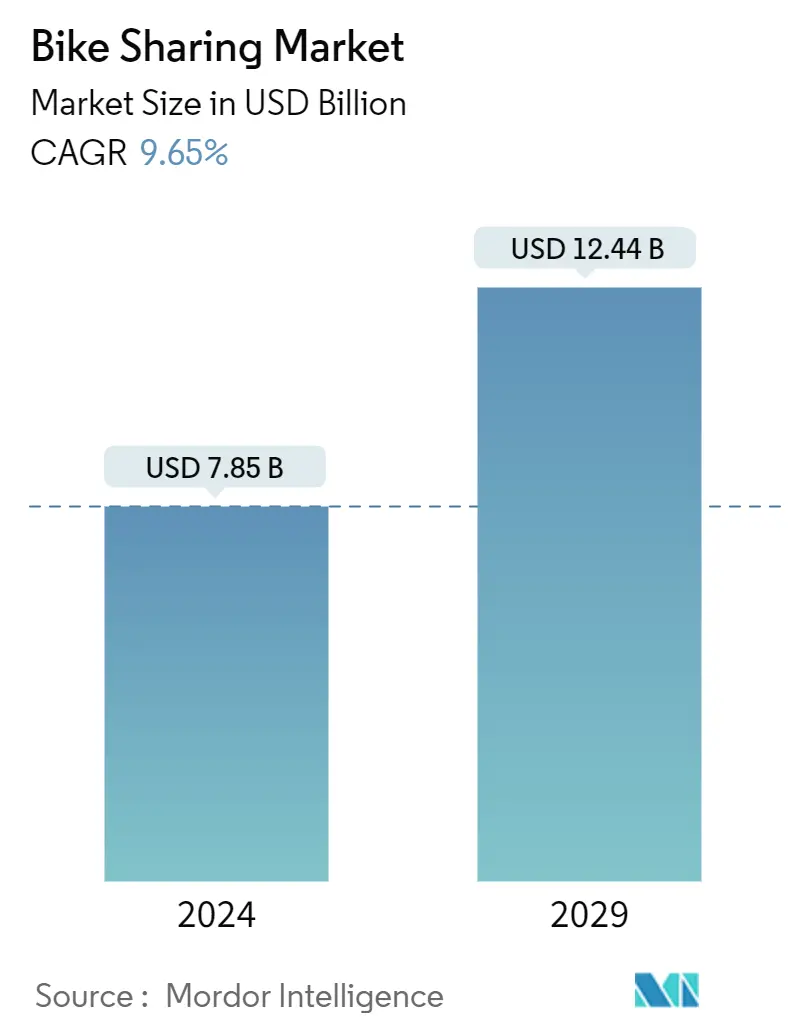Market Size of Bike Sharing Industry

| Study Period | 2019 - 2029 |
| Market Size (2024) | USD 7.85 Billion |
| Market Size (2029) | USD 12.44 Billion |
| CAGR (2024 - 2029) | 9.65 % |
| Fastest Growing Market | North America |
| Largest Market | Asia Pacific |
Major Players
*Disclaimer: Major Players sorted in no particular order |
Bike Sharing Market Analysis
The Bike Sharing Market size is estimated at USD 7.85 billion in 2024, and is expected to reach USD 12.44 billion by 2029, growing at a CAGR of 9.65% during the forecast period (2024-2029).
The rise in vehicular gas emissions and noise is leading to high levels of pollution in major cities worldwide. The demand for clean energy and high-powered vehicles is simultaneously witnessing a healthy growth rate, and this is anticipated to drive the global market for bike-sharing.
Moreover, the growing need for urban transportation periodically increases the number of vehicles on roads, which leads to heavy traffic congestion and high environmental pollution. Bike-sharing programs have been widely adopted by regions like Asia-Pacific, North America, and Europe to alleviate the above-mentioned issues. Many bike-sharing operators have started focusing on expanding their fleet of e-bike services to sustain themselves in the growing competition in the bike-sharing market.
The growing number of technological advancements, such as the proliferation of GPS technology, consumer-ready mobile payments, and the Internet of Things (IoT), and the reduction in investment costs of locking and tracking systems for bikes have led to the introduction of dockless bike-sharing systems in the market.
The dockless bike-sharing system has resulted in better bike-sharing services for the growing urban commutes. The system allows the ease of transit access by offering users the sheer flexibility of picking up and dropping off bikes freely at any legal public vehicle parking lot instead of the operator’s bike stations.
Bike Sharing Industry Segmentation
Bike sharing is the provision of making bicycles available for shared use through a self-service rental scheme in which people can hire them for short-term use.
The scope of the bike-sharing market is segmented by bike type, sharing system, and geography. By bike type, the market is segmented into traditional/regular bikes and e-bikes. By sharing system, the market is segmented into docked and dockless. By geography, the market is segmented into North America, Europe, Asia-Pacific, and the Rest of the World. The profiles of major players in the market are also covered in the report, along with their market shares. The report offers the market size and forecasts in value (USD) for all the above segments.
| By Bike | |
| Traditional/Regular Bike | |
| E-bike |
| By Sharing System | |
| Docked | |
| Dockless |
| By Geography | |
| North America | |
| Europe | |
| Asia-Pacific | |
| Rest of the World |
Bike Sharing Market Size Summary
The bike-sharing market is poised for significant growth, driven by increasing urbanization and the need for sustainable transportation solutions. As cities worldwide grapple with pollution and traffic congestion, bike-sharing programs have emerged as a viable alternative to traditional vehicular transport. The market is experiencing a shift towards e-bikes, particularly in regions like Asia-Pacific, North America, and Europe, where the demand for eco-friendly and efficient urban mobility solutions is on the rise. Technological advancements, such as GPS, mobile payments, and IoT, have facilitated the development of dockless bike-sharing systems, enhancing user convenience and service efficiency. These systems allow users to pick up and drop off bikes at any legal public parking spot, offering greater flexibility and accessibility.
The market's expansion is further supported by government initiatives and investments aimed at promoting greener transportation options. Countries like China, Brazil, the United States, Germany, Italy, and India are leading the charge in e-bike adoption, driven by both consumer demand and regulatory support. The Asia-Pacific region, particularly China, is expected to maintain its dominance in the market due to high bicycle sales and increasing e-bike consumption. In India, the growing popularity of cycling sports and government efforts to promote bike-sharing services are contributing to market growth. Major players in the industry, including Lyft, Uber, and TIER Mobility, are actively expanding their services and investing in new technologies to capture a larger market share. As the bike-sharing market continues to evolve, it is anticipated to experience robust growth, addressing the dual challenges of urban mobility and environmental sustainability.
Bike Sharing Market Size - Table of Contents
-
1. MARKET DYNAMICS
-
1.1 Market Drivers
-
1.1.1 Increasing Inclusion of E-bikes in the Sharing Fleet
-
-
1.2 Market Restraints
-
1.2.1 Limited Infrastructure May Hinder Market Growth
-
-
1.3 Industry Attractiveness - Porter's Five Forces Analysis
-
1.3.1 Threat of New Entrants
-
1.3.2 Bargaining Power of Buyers/Consumers
-
1.3.3 Bargaining Power of Suppliers
-
1.3.4 Threat of Substitute Products
-
1.3.5 Intensity of Competitive Rivalry
-
-
-
2. MARKET SEGMENTATION
-
2.1 By Bike
-
2.1.1 Traditional/Regular Bike
-
2.1.2 E-bike
-
-
2.2 By Sharing System
-
2.2.1 Docked
-
2.2.2 Dockless
-
-
2.3 By Geography
-
2.3.1 North America
-
2.3.2 Europe
-
2.3.3 Asia-Pacific
-
2.3.4 Rest of the World
-
-
Bike Sharing Market Size FAQs
How big is the Bike Sharing Market?
The Bike Sharing Market size is expected to reach USD 7.85 billion in 2024 and grow at a CAGR of 9.65% to reach USD 12.44 billion by 2029.
What is the current Bike Sharing Market size?
In 2024, the Bike Sharing Market size is expected to reach USD 7.85 billion.

